Classification / Names
Common names from other countries
Main reference
Size / Weight / Age
Max length : 35.0 cm SL male/unsexed; (Ref. 3810); common length : 23.0 cm SL male/unsexed; (Ref. 3810)
Length at first maturity
Lm ?, range 15 - ? cm
Environment
Marine; demersal; non-migratory; depth range 1 - 220 m (Ref. 9785), usually 18 - 33 m (Ref. 54679)
Climate / Range
Tropical, preferred 27°C (Ref. 107945); 39°N - 20°S, 106°E - 140°E (Ref. 54679)
Distribution
Short description
Dorsal
spines
(total): 10;
Dorsal
soft rays
(total): 9;
Anal
spines: 3;
Anal
soft rays: 8. Suborbital spine absent. Preopercle with 3 transverse scale rows. Pectoral and pelvic fins long, reaching to between level of anus and origin of anal fin. Upper lobe of caudal fin produced to form a trailing filament. A line drawn up from the posterior edge of suborbital reaching the dorsal profile 5 to 7 scale rows before origin of dorsal fin. Axillary scale present. Body color pink, paler below. Head pink, a yellow stripe from upper lip extending to antero-ventral margin of eye. Two faint yellow bars across cheek sometimes present. Pelvic fins with yellow stripes.
IUCN Red List Status (Ref. 115185)
Threat to humans
Harmless
Human uses
Fisheries: commercial
More information
ReferencesAquacultureAquaculture profileStrainsGeneticsAllele frequenciesHeritabilityDiseasesProcessingMass conversion
Tools
Special reports
Download XML
Internet sources
Estimates of some properties based on models
Phylogenetic diversity index
PD50 = 0.5000 many relatives (e.g. carps) 0.5 - 2.0 few relatives (e.g. lungfishes)
Trophic Level
4.0 ±0.57 se; Based on food items.
Resilience
Medium, minimum population doubling time 1.4 - 4.4 years (K=0.24-0.45; Fec=2,000)
Vulnerability
Low to moderate vulnerability (35 of 100)
Price category
